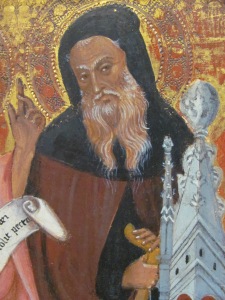Earlier this summer, I was blessed to be raised to the rank of Professor of Christian History at Davenant Hall. During the interview, which was one of the best live (alas, not in-person) theological conversations I’ve had in a very long time, one of my colleagues remarked that he thinks it’s cool that we, a Protestant theological college, are offering a course on the Desert Fathers. (Sign up here!)
But, of course, the question is always: How do I sell this to my fellow Protestants?
Why study the Desert Fathers with me? Or at all?
For some people, the Desert Fathers and the entire monastic movement that flows from them represent something in Christianity that is unnecessary at best, Pelagian at worst. Isn’t asceticism an unholy hatred of the body? Don’t the Desert Fathers teach works righteousness?
If we want to answer these questions, we must quickly (if briefly for a blog post) go to the sources (ad fontes! in good Reformational fashion). What is asceticism? What do the Desert Fathers believe about grace? Can we today learn things from them?
Asceticism comes from the Greek word askesis, which is the Greek word for “training”, like athletic training — askesis is the word St Athanasius uses to describe the lifestyle and path of St Antony the Great. It is, then, more like “spiritual training” than hatred of the body. However, the entire human life is lived in the body. Therefore, the training of most Christians in history has involved embodied aspects — and, when healthy, no hatred of the body. Fasting, for example, is simply, well, expected of us by our Lord. And simple eating, simple living, are themselves caught up in various Scriptural injunctions, not to mention St Clement of Alexandria’s Paedagogus.
Here is the lifestyle of St Antony as described by St Athanasius:
All his desire and all his energies he directed toward the great effort of ascetic discipline. So he worked with his hands, having heard ‘Let the lazy person not eat’. [2 Thes 3:10] He would spend part of what he earned on bread and part of it he would give to those who were begging. He prayed all the time, having learned that it is necessary to pray by oneself without ceasing. [See Mt 16:6 and 1 Thes 5:17] Indeed, he paid such close attention to the reading of Scripture that nothing in the Scriptures was wasted. He remembered everything, with the result that for him memory took the place of books.
Life of Antony, 3.5-7, trans. Vivian and Athanassakis
Somewhere, either Evagrius or the Life of Antony, the mean between abuse of the body and its indulgence is counselled in the wisdom of the Desert. The Desert Fathers do not hate the body.
Oh, and before addressing grace, look at where St Antony’s inspiration for askesis came from: Scripture. Indeed, he seems to have lived a life saturated with the Bible, doesn’t he? This is their ideal. In the first monasteries that shared a common life, besides a regular round of praying the Psalms and other Bible-reading, they had major Bible teaching twice a week.
What about grace? The Desert Fathers, after all, expend a lot of energy teaching about, well, expending a lot of energy. One of the famous sayings is that prayer is hard work until your last breath. Where, then, does grace fit in? Here’s what Evagrius says in his short work On the Eight Thoughts:
A great thing is the human being who is helped by God; he is abandoned and then he realizes the weakness of his nature. You have nothing good which you have not received from God (cf. 1 Cor. 4:7). Why then do you glory in another’s good as if it were your own? Why do you pride yourself in the grace of God as if it were your own possession? Acknowledge the one who gave it and do not exalt yourself so much. You are a creature of God; do not reject the Creator. You receive help from God; do not deny your benefactor. (8.12)
In Evagrius of Pontus: The Greek Ascetic Corpus, trans. Robert E Sinkewicz, p. 88.
Evagrius goes on, but I think you get the point.
Finally, there’s a historical reason to study any of the pre-Reformational monastic texts. As Dallas Willard notes in his book The Spirit of the Disciplines, the best books about the spiritual disciplines from Benedict onwards (if not from St Antony onwards…) were written by or about monks. But that doesn’t mean we can’t learn from them and apply their wisdom to our own situation.
Indeed, we learn Trinitarian theology, Christology, the doctrine of God, ethics, morality, theology of the human will, semiotics, political theology, demonology, diabology (is that the word?), angelology, and (depending on your tradition) church order, liturgy, and canon law from the Fathers.
Why not the spiritual disciplines?
And if so, why not the fathers who were devoted to nothing else in their undivided pursuit of God?







